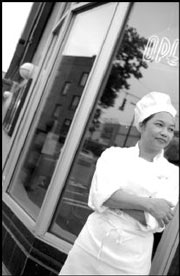RACHA NOODLES AND THAI CUISINE 23 Mercer, 281-8883 lunch weekdays, dinner every day (till 2 a.m. Fri.-Sun.)
Most of us made the acquaintance of Thai cooking when looking for something healthy, fast, and cheap. Thai food is all those things, but it’s much more—one of the wonders of the culinary world, in fact. But as long as we go on ordering the same old tom yung goong, chicken satay, and phad Thai, that world remains far away.
Just how far became clear with the publication less than two years ago of Cracking the Coconut. There had been books in English about Thai cuisine before, but none to hold a candle to Su-Mei Yu’s encyclopedic, passionate, and personal tome. For the first time, recipes weren’t “adapted for the American kitchen” to the point of caricature, and Thai food was placed in its proper context as one of the central unifying elements in an ancient and complex culture.
Reading Coconut and its just-published sequel, Asian Grilling, is exciting and inspiring—but frustrating, too, if you aren’t ready to spend hours weekly at Asian markets shopping for arcane ingredients with unpronounceable names, and months if not years mastering unfamiliar ways of preparing and serving them. But the food in most Thai restaurants, while wholesome and tasty, resembles the savoro-textural kaleidoscope of a real Thai dinner table about as much as a burger and fries do a bang-up Thanksgiving dinner.
It’s our own fault. Thai restaurateurs, constantly dealing with “Not too hot, now” from their American customers, have concluded that we can’t handle anything that’s not cozily familiar, so they tend to go easy not only on the hot peppers—an essential condiment in nearly every Thai dish, including fruit salad—but on other basic herbs, vegetables, and seasonings of the Thai kitchen: bitter melon, tamarind, dried shrimp, turmeric root, betel leaf, fish sauce. In Thailand, rice is the center, the substance, the essence of every sit-down meal; Americans’ ravenousness for meat makes rice peripheral, a side dish.
How to break the cycle of indulgence pandering to ignorance? Six months ago, the management of Racha Restaurant Group, which operates restaurants in Woodinville, Everett, and Renton as well as its namesake outlet at First North and Mercer, landed a prize when Buppha Booma signed on as the chain’s executive chef. With nearly 30 years in the restaurant trade in Thailand and Europe, Booma, known to all as “Chef Daeng,” is no narrow purist. She earned her spurs at Bangkok’s Queen’s Park Hotel with a menu drawing on regional Thai cuisines at a time when Western cooking was all the rage in sophisticated circles, but she had no difficulty during eight years in France adapting Thai techniques to non-Thai ingredients: beef and lamb, ahi tuna and salmon.
Her way with such ingredients can be sampled on Racha’s dinner menu for $12.95: ahi tuna lightly seared in olive oil, then dressed in a “salsa” of pur饤 jalape� sea salt, peppercorns, and cilantro—a mixture as central to Thai cooking as soy sauce is to Japanese. “Savory lamb satay” ($10.95) is not skewers but whole lamb cutlets, marinated in a lemon grass/cilantro/yellow curry olive oil rub, then grilled and served with satay-style peanut dip. With grilled salmon ($15.95), she risks a powerful saucing of pounded hot chilis and garlic swimming in lime juice and fish sauce, but the salmon comes shining through, its sweet oiliness enhanced by the contrast.
Dishes that look to Western eyes wholly traditional actually feature Chef Daeng’s heretical personal twists on tradition. In Thailand, pandanus leaf is used primarily to give aroma to rice and sweets, rather like bay or vanilla bean in Western cuisine. In “Chicken in the Jungle” (one of those fanciful names so common on Thai menus here and so rare in Thailand), she instead folds its long stiff fibers round chunks of chicken breast, then deep-fries the little bundles, serving the musty-scented results with a mild sweet-and-sour sauce ($8.50). “Fruity Fruity” yum ($7.50) is a radically chastened version of Thai fruit salad—chicken and melon tossed in a mildly tangy lime and coconut milk dressing, with none of the searing pepper-heat of most Thai yums.
Daeng’s Racha menu (due to be implemented in time at other outlets in the chain) contains some Thai classics, like training-wheels versions of papaya yum, with hot chilis, green beans, dried shrimp, and peanuts ($7.95), and the notorious “Crying Tiger” yum—beef strips in a vinaigrette of fragrant herbs and, alas, not nearly enough fiery bird chilis to deserve its nickname ($9.95).
Every single dish is delicious; none offers the full revelatory impact of no-holds-barred Thai cooking, apparently because it’s feared the diner can’t deal with Thai reality. Let’s show them we can: When they bring you a bowl of miso soup and chopsticks at lunch, explain politely that if you wanted Japanese or Chinese food, you wouldn’t have come to a Thai restaurant (Thais rarely eat the former or use the latter). When your food comes, ask for the traditional little dish of finely chopped, flaming hot chilis in fish sauce, provided so each diner can zing things up to taste. Forget about mee crob—fried, puffed rice noodles drenched with caramelized palm sugar—as a cloying appetizer laced with ground chicken; have it in its classic role as accompaniment to hot curry dishes—Racha offers eight. Remember, Thai food’s not too hot if you eat it the way Thais do, with lots and lots of glorious jasmine rice (only $1.75 a serving). Tell the kitchen to let ‘er rip. You’ll find you can not only take it, but you’ll keep coming back for more.









